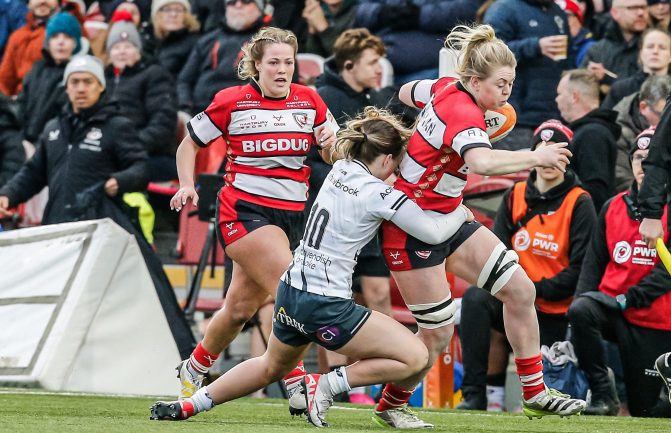The return of the Allianz Cup, now named the PWR Cup for reasons unexplained, is a brave move that we must hope brings all the success it deserves.
It will run from 23 August to 12 October, in other words in direct competition with the World Cup, also taking place in England (those dates: 22 August – 27 September). Yet the PWR statement claims: “The PWR Cup is back to kick off a memorable season”. Since it starts one day after the World Cup, it won’t, and we may assume the RFU will have every publicity gun aimed directly at the Stadium of Light, as the USA Eagles run out to down English colours.
What effect will that have on games scheduled for the next day at Loughborough, Burton, Cobham and Trailfinders? It’s a worthy decision taking matches away from the usual PWR centres, but will it pull in the crowds? The Leicester Tigers v Loughborough Lightning fixture to be played at Lichfield is very poignant. Lichfield was the club not admitted to the Premier 15s, despite its huge success (England players galore – at least four still in line for the RWC). Leicester linked with the Staffordshire club 40 miles away.
A second statement: “Now firmly established as a cornerstone of the elite women’s rugby calendar…” is confusing. The Cup wasn’t contested last year, so ’firmly’?
I hope a third claim of “fast, fearless rugby” proves true. That has been a prime calling card of the PWR, but we may yet see packs preferring a slow powerful thrust to the line, and scrum-halves following Ella Wyrwas’ expert coaching session on the box-kick – the surest way to bring the game to a halt.
Fair shares for all
One ongoing difficulty facing the RFU and PWR is how to ensure every player on a club’s books gets a fair crack of the whip. Dual accreditation has been used, but that provides its own range of problems, including the distance between the two clubs involved, and the willingness of individuals to make way for a part-time incomer. Only 23 are involved directly in each round of the league, leaving vast numbers unemployed.
Clubs have been busy establishing links with local junior clubs. New breaks today of Loughborough strengthening its ties with Buckingham Swans. Both head coaches point to the advantages they bring their club.
This lack of game-time was a major reason for introducing the Cup. After it vanished last year, it reappears just in time to clash with a much bigger event.
32 Red Roses will be otherwise engaged, plus an untold number of players representing other nations. Since clubs are announcing almost daily comings and goings, it’s impossible to put an exact number on them, but it will come to many dozens. Loughborough reckon around 30 on their own books.
The ones who matter most are we must now call ‘next-gen’ (the term preferred by the gentleman who dreamt up both cricket’s Hundred and “The Prem” – I missed my true calling). This is where the league has been doing a fine job, unearthing more and more young talent.
Standalone?
The scheduling calls into question the amount of public engagement the Cup can draw. It means it has to ride on the back of the RWC as worldwide attention is drawn to the women’s game. It’s a big ask. There is such a thing as saturation point. The RWC offers twenty-four pool games, before we get to the nitty-gritty of the knock-out stages. How much energy will fans have left over to enjoy the PWR Cup?
The claim is, the Cup will give PWR clubs “the chance to further strengthen their ties to local grassroots clubs and their fans”. A laudable target, but set directly against such competition?
What effect will that opening day at Sunderland have on games scheduled for the next day at Loughborough, Burton, Cobham and Trailfinders? Can they pull in the crowds?
Fixture-setting
Once again the reduction of the league to nine clubs brings unwanted complications. It’s normal for preliminary stages to divide into pools, but in this case it means Pool A contains four clubs (Gloucester-Hartpury, Harlequins, Exeter Chiefs and Trailfinders) and Pool B five (Saracens, Bristol Bears, Loughborough Lightning, Leicester Tigers and Sale Sharks). I’ll leave you to decide which version is preferable, but the imbalance is disturbing.
So too the dates and timings. There is no regularity that allows spectators to be sure on which day a local game is starting and when. Some take place on a Saturday, others a Sunday. Matches kick off between noon and 15.00. On four consecutive Saturdays there are four, two, two and one games.
The statement claims the tournament is fan-based. I suspect most fans, rather like commuters, prefer a regular schedule that is easy to remember.
Nor is it clear what ‘Sunday 24 August Saturday 30 August’ means on the published fixture-list. And again: “The ninth team were drawn into the pools randomly to determine which pool had the make-up of five teams.” (?) Shaftesbury Park needs an E in the middle.
We must hope that the Cup proves a success, as it presents a real chance for players normally excluded from the big time to make their mark.









